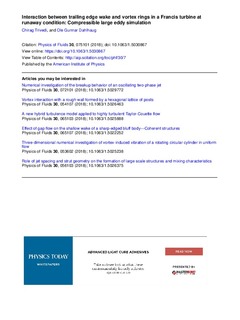| dc.contributor.author | Trivedi, Chirag | |
| dc.contributor.author | Dahlhaug, Ole Gunnar | |
| dc.date.accessioned | 2018-07-09T11:33:01Z | |
| dc.date.available | 2018-07-09T11:33:01Z | |
| dc.date.created | 2018-07-02T21:21:21Z | |
| dc.date.issued | 2018 | |
| dc.identifier.citation | Physics of fluids. 2018, 30 (7), . | nb_NO |
| dc.identifier.issn | 1070-6631 | |
| dc.identifier.uri | http://hdl.handle.net/11250/2504805 | |
| dc.description.abstract | The present study aims to investigate the unsteady flow phenomenon that produces high energy stochastic fluctuations in a highly skewed blade cascade. A complex structure such as a turbine is operated at runaway speed, where the circumferential velocity is dangerously high, and the energy dissipation is so significant that it takes a toll on the operating life of a machine. Previous studies showed that a large vortical structure changes spatial location very quickly and interacts with the secondary flow attached to the blade pressure-side. The temporal inception of the rings dissipates the energy of a wide frequency band and induces heavy vibration in the mechanical structure. The focus of the present study is to experimentally measure and numerically characterize the time-dependent inception of vortical rings in the blade cascade. The experimental data are used to verify and validate the numerical results obtained from the large eddy simulation. Flow compressibility is considered to obtain more accurate amplitudes of unsteady pressure pulsations associated with the wave propagation and reflection. The following three aspects are of particular focus: (1) How the wake from a guide vane interacts with the stagnation point of a blade, (2) How vortex rings are developed in a blade cascade, and what are the temporal characteristics, and (3) How decelerating flow at the outlet interacts with the secondary flow in the blade cascade. | nb_NO |
| dc.language.iso | eng | nb_NO |
| dc.publisher | AIP Publishing | nb_NO |
| dc.title | Interaction between trailing edge wake and vortex rings in a Francis turbine at runaway condition: Compressible large eddy simulation | nb_NO |
| dc.type | Journal article | nb_NO |
| dc.type | Peer reviewed | nb_NO |
| dc.description.version | publishedVersion | nb_NO |
| dc.source.pagenumber | 20 | nb_NO |
| dc.source.volume | 30 | nb_NO |
| dc.source.journal | Physics of fluids | nb_NO |
| dc.source.issue | 7 | nb_NO |
| dc.identifier.doi | 10.1063/1.5030867 | |
| dc.identifier.cristin | 1595302 | |
| dc.relation.project | Norges forskningsråd: 254987 | nb_NO |
| dc.relation.project | Notur/NorStore: NN9504K | nb_NO |
| dc.description.localcode | Published by AIP Publishing. Locked until 2.7.2019 due to copyright restrictions. This article may be downloaded for personal use only. Any other use requires prior permission of the author and AIP Publishing. The following article appeared in Journal of Applied Physics and may be found at https://aip.scitation.org/doi/pdf/10.1063/1.5030867 | nb_NO |
| cristin.unitcode | 194,64,25,0 | |
| cristin.unitname | Institutt for energi- og prosessteknikk | |
| cristin.ispublished | true | |
| cristin.fulltext | postprint | |
| cristin.qualitycode | 2 | |
